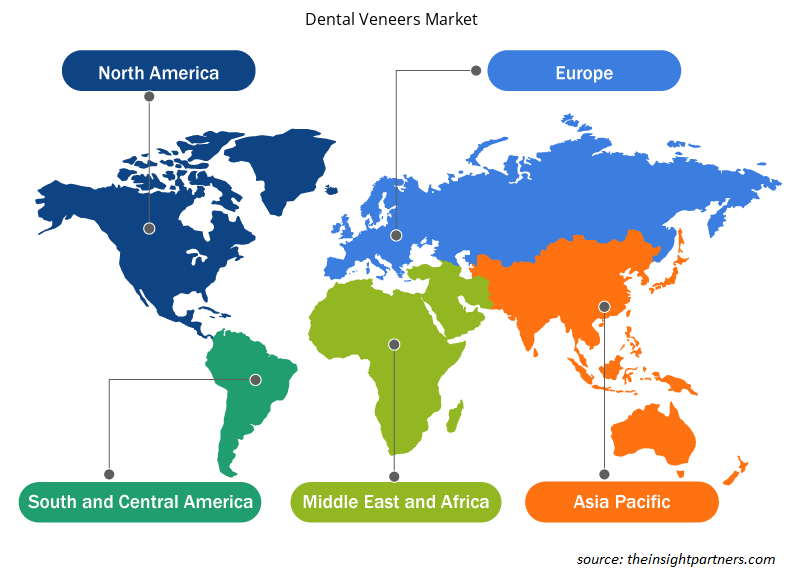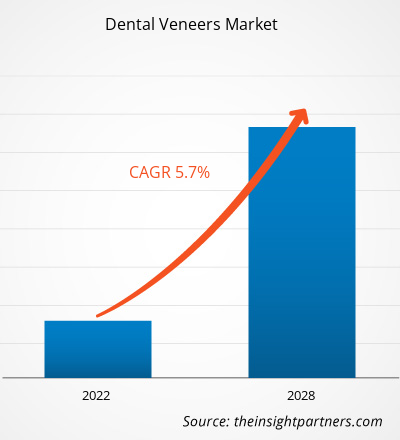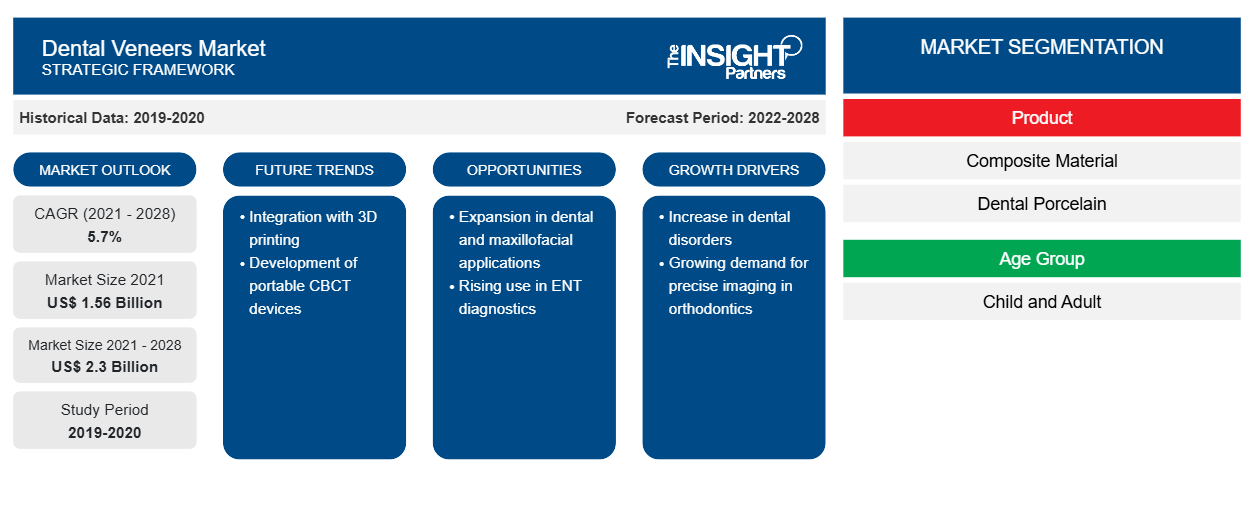Si prevede che il mercato delle faccette dentali crescerà da 1.559,28 milioni di dollari nel 2021 a 2.302,60 milioni di dollari entro il 2028; si stima che crescerà a un CAGR del 5,7% nel periodo 2021-2028.
Le faccette dentali, chiamate anche faccette in porcellana o laminati in porcellana dentale , sono gusci sottilissimi realizzati su misura in materiali del colore dei denti, destinati a coprire la superficie anteriore dei denti per migliorarne l'aspetto. Questi gusci vengono posizionati davanti ai denti per modificarne il colore, la forma, le dimensioni o la lunghezza. Il trattamento per ogni paziente è personalizzato in base alle sue esigenze. L'incollaggio delle faccette dentali viene eseguito con cemento resinoso.
La crescita del mercato delle faccette dentali è attribuita all'aumento dei casi di disturbi dentali, alla crescente consapevolezza dei consumatori in merito alle cure odontoiatriche e alla crescente attenzione all'estetica. Tuttavia, l'elevato costo delle procedure odontoiatriche cosmetiche ostacola la crescita del mercato.
Personalizza questo report in base alle tue esigenze
Riceverai la personalizzazione gratuita di qualsiasi report, comprese parti di questo report, o analisi a livello nazionale, pacchetto dati Excel, oltre a usufruire di grandi offerte e sconti per start-up e università
- Scopri le principali tendenze di mercato in questo rapporto.Questo campione GRATUITO includerà analisi di dati che spaziano dalle tendenze di mercato alle stime e alle previsioni.
Approfondimenti di mercato
Aumento dei casi di disturbi dentali
La domanda globale di faccette dentali è in espansione a causa di problemi dentali crescenti come scolorimento, anomalie, denti scheggiati e spaziatura irregolare tra i denti. Le faccette dentali sono utilizzate in vari contesti, come istituti odontoiatrici, ospedali e cliniche odontoiatriche, portando a statistiche di crescita positive per il mercato delle faccette dentali. Le faccette in porcellana possono guadagnare una quota di mercato sostanziale grazie a vantaggi come il materiale durevole e la capacità di migliorare l'aspetto dei denti. Inoltre, le faccette dentali non impongono alcuna manutenzione specifica; richiedono un'igiene orale di base per mantenerle in buone condizioni. Di conseguenza, queste variabili possono contribuire all'aumento del tasso di crescita del mercato. Secondo una recente ricerca dell'American Academy of Cosmetic Dentistry (AACD), la domanda di faccette in porcellana è aumentata più che mai. Infatti, in termini di popolarità negli Stati Uniti, questa procedura di odontoiatria estetica è solo per lo sbiancamento dei denti. Secondo l'Organizzazione mondiale della sanità nel 2019, le malattie orali hanno colpito quasi 3,5 miliardi di persone. Secondo il sondaggio dell'International Society of Aesthetic Plastic Surgery (ISAPS) del 2018, i primi 5 paesi che eseguono il maggior numero di interventi di chirurgia estetica sono Stati Uniti, Brasile, Messico, Germania e India. Stati Uniti e Brasile hanno rappresentato il 28,4% di tutte le procedure estetiche, chirurgiche e non chirurgiche, nel mondo nel 2018. Secondo Cosmetic Surgery Solicitors, un'azienda leader nel settore della chirurgia estetica, Brasile e Stati Uniti hanno eseguito la stessa quantità di interventi di chirurgia estetica (1,5 milioni di procedure ciascuno). Negli Stati Uniti il numero di persone sottoposte a procedure non chirurgiche è stato più di tre volte superiore rispetto al Brasile: negli Stati Uniti sono stati eseguiti 2,8 milioni di trattamenti estetici rispetto ai 769.000 in Brasile. Il sondaggio annuale dell'ISAPS ha rilevato che i trattamenti non invasivi sono aumentati del 10,2% in tutto il mondo nel 2020. Le varie offerte e gli sconti dei dentisti possono aiutare il mercato delle faccette dentali a crescere.AACD), demand for porcelain veneers has increased more than ever before. In fact, in terms of popularity in the US, this cosmetic dentistry procedure is only for teeth whitening. According to the World Health Organization in 2019, oral diseases affected nearly 3.5 billion people. According to the International Society of Aesthetic Plastic Surgery (ISAPS) survey of 2018, the top 5 countries that perform the most cosmetic surgeries are the US, Brazil, Mexico, Germany, and India. The US and Brazil accounted for 28.4% of all cosmetic procedures - surgical and nonsurgical - in the world in 2018. According to Cosmetic Surgery Solicitors, a leading cosmetic surgery company, Brazil and the US performed equal cosmetic surgeries (1.5 million procedures each). More than three times the number of people in the US underwent nonsurgical procedures than in Brazil - 2.8 million cosmetic treatments were carried out in US compared to 769,000 in Brazil. The annual survey from ISAPS found that noninvasive treatments increased by 10.2% worldwide in 2020. Dentists' various offers and discounts may assist the dental veneers market to grow.
Approfondimenti basati sui prodotti
Il mercato globale delle faccette dentali, in base al prodotto, è segmentato in materiale composito , porcellana dentale e altri. Il segmento dei materiali compositi ha detenuto la quota maggiore del mercato nel 2021. Tuttavia, si prevede che il segmento della porcellana dentale registrerà un CAGR del 6,4% nel mercato durante il periodo di previsione. CAGR of 6.4% in the market during the forecast period.
Informazioni basate sull'utente finale
In base all'utente finale, il mercato globale delle faccette dentali è segmentato in ospedali, cliniche odontoiatriche e altri. Il segmento delle cliniche odontoiatriche ha detenuto la quota maggiore del mercato nel 2021 a causa del crescente numero di strutture di cliniche odontoiatriche in tutto il mondo. Secondo i Centers for Disease Control and Prevention (CDC), nel 2020, circa il 63,0% degli adulti di età pari o superiore a 18 anni ha visitato le cliniche odontoiatriche. Inoltre, si prevede che lo stesso segmento registrerà un CAGR del 5,8% nel mercato durante il periodo di previsione.CAGR of 5.8% in the market during the forecast period.
I lanci e le approvazioni di prodotti sono strategie comunemente adottate dalle aziende per espandere la loro presenza globale e i portafogli di prodotti per dominare il mercato delle faccette dentali. Inoltre, gli operatori di mercato si concentrano sulla strategia di partnership per ampliare la loro clientela, il che, a sua volta, consente loro di mantenere il loro marchio a livello globale. Si prevede che il mercato delle faccette dentali prospererà nei prossimi anni grazie allo sviluppo di prodotti innovativi da parte degli operatori di mercato.
Approfondimenti regionali sul mercato delle faccette dentali
Le tendenze regionali e i fattori che influenzano il mercato delle faccette dentali durante il periodo di previsione sono stati ampiamente spiegati dagli analisti di Insight Partners. Questa sezione discute anche i segmenti e la geografia del mercato delle faccette dentali in Nord America, Europa, Asia Pacifico, Medio Oriente e Africa e America centrale e meridionale.

- Ottieni i dati specifici regionali per il mercato delle faccette dentali
Ambito del rapporto sul mercato delle faccette dentali
| Attributo del report | Dettagli |
|---|---|
| Dimensioni del mercato nel 2021 | 1,56 miliardi di dollari USA |
| Dimensioni del mercato entro il 2028 | 2,3 miliardi di dollari USA |
| CAGR globale (2021 - 2028) | 5,7% |
| Dati storici | 2019-2020 |
| Periodo di previsione | 2022-2028 |
| Segmenti coperti | Per Prodotto
|
| Regioni e Paesi coperti | America del Nord
|
| Leader di mercato e profili aziendali chiave |
|
Densità degli attori del mercato delle faccette dentali: comprendere il suo impatto sulle dinamiche aziendali
Il mercato delle faccette dentali sta crescendo rapidamente, spinto dalla crescente domanda degli utenti finali dovuta a fattori quali l'evoluzione delle preferenze dei consumatori, i progressi tecnologici e una maggiore consapevolezza dei benefici del prodotto. Con l'aumento della domanda, le aziende stanno ampliando le loro offerte, innovando per soddisfare le esigenze dei consumatori e capitalizzando sulle tendenze emergenti, il che alimenta ulteriormente la crescita del mercato.
La densità degli operatori di mercato si riferisce alla distribuzione di aziende o società che operano in un particolare mercato o settore. Indica quanti concorrenti (operatori di mercato) sono presenti in un dato spazio di mercato in relazione alle sue dimensioni o al valore di mercato totale.
Le principali aziende che operano nel mercato delle faccette dentali sono:
- Glidewell
- Amann Girrbach AG
- 3 milioni
- VladMiVa
- Ceramica di zircone
Disclaimer : le aziende elencate sopra non sono classificate secondo un ordine particolare.

- Ottieni una panoramica dei principali attori del mercato delle faccette dentali
Profili aziendali
- Dentsply Sirona
- Glidewell
- Prodotti Ultradent, Inc.
- Amann Girrbach AG
- 3 milioni
- VladMiVa
- Ceramica di zircone
- Società a responsabilità limitata
- PLANMECA OY
- Cura dentale del leone
- Azienda
- Ivoclar Vivadent AG
- Henkel AG & Company, KGAA
- Allinea la tecnologia
- Azienda Colgate-Palmolive
- Koninklijke Philips NV
- Analisi storica (2 anni), anno base, previsione (7 anni) con CAGR
- Analisi PEST e SWOT
- Valore/volume delle dimensioni del mercato - Globale, Regionale, Nazionale
- Industria e panorama competitivo
- Set di dati Excel
Report recenti
Rapporti correlati
Testimonianze
Motivo dell'acquisto
- Processo decisionale informato
- Comprensione delle dinamiche di mercato
- Analisi competitiva
- Analisi dei clienti
- Previsioni di mercato
- Mitigazione del rischio
- Pianificazione strategica
- Giustificazione degli investimenti
- Identificazione dei mercati emergenti
- Miglioramento delle strategie di marketing
- Aumento dell'efficienza operativa
- Allineamento alle tendenze normative





















 Ottieni un campione gratuito per - Mercato delle faccette dentali
Ottieni un campione gratuito per - Mercato delle faccette dentali